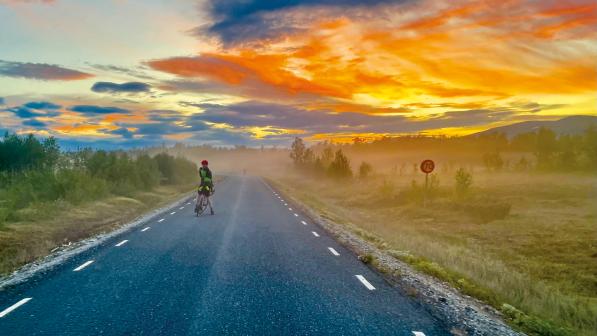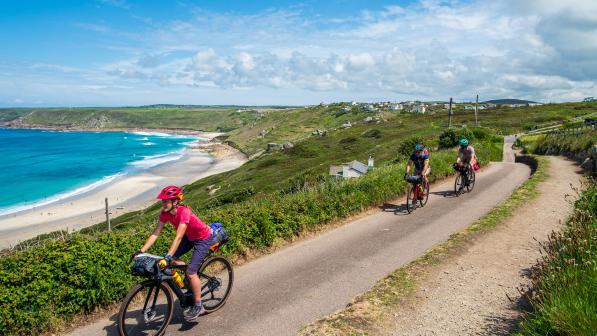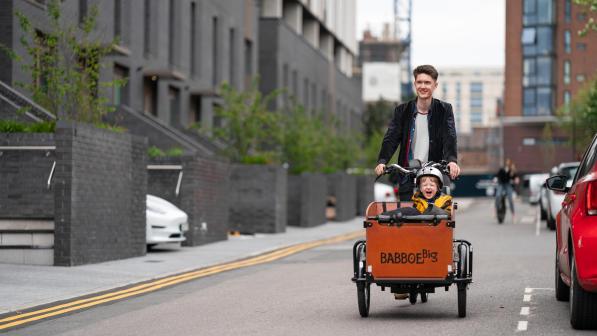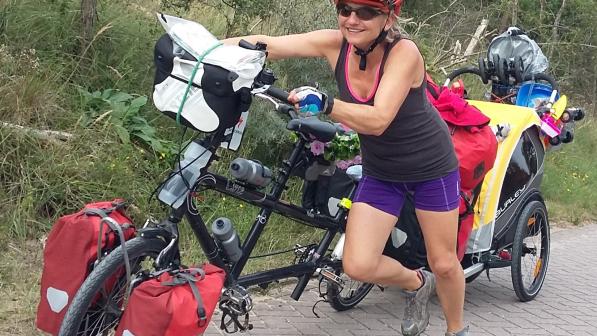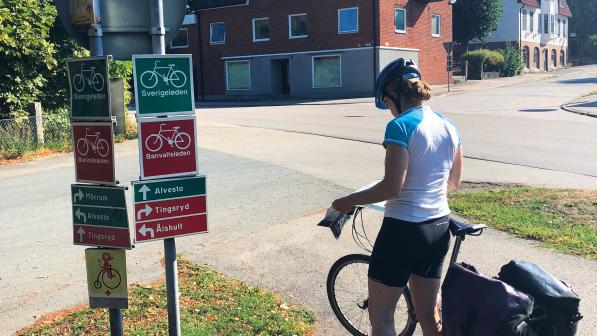Great Rides: Coasting through Sweden

Sweden’s premier long-distance cycling route, Kattegattleden, runs right past the bottom of the garden of our house in Sweden. So in spring and summer, when we are there each day, we look out of our dining room window at a steady flow of cycle tourers and other cyclists going north or south.
Kattegattleden takes its name from the sea between Sweden and Denmark: Kattegatt. The route follows the coast from Helsingborg in the province of Skåne in the very south of Sweden, through the next province going north (Halland), and finishes in Gothenburg in the province of Bohuslän, closer to the border with Norway.
Cycle tracks comprise much of the route, with occasional sections on small lanes or dirt roads away from the regular flows of motor traffic. It was created on 6 June 2015 as the first national long-distance cycle route in the country. Before that it existed as just an assembly of regional and local routes – Ginstleden in the south and Sverigeleden in the north. One of main benefits of the transition to Kattegattleden has been a major improvement in signposting. This makes navigating the route very easy.
Back in 2011, when it was classed as Ginstleden, I cycled the southern section from the fishing village of Träslövsläge (where our home is) to Helsingborg. It was about 220km over three days. Ginstleden means ‘the pathway through gorse bushes’. For me it was a lovely introduction to long-distance cycling in Sweden, having just brought over one of my touring bikes from England to begin a more serious spell of riding and exploring the Swedish countryside.

On a recent visit to Sweden I decided I would complete the remaining section of the full Kattegattleden route by riding the final two days of the northerly section from our base in the Träslövsläge. It seemed like good way to loosen up for a longer journey down the west coast of France that I was due to take on before the end of the month.
But the experience also served to remind me of the pleasures of cycle touring in Sweden, a country of just 10 million people and twice the land mass of the UK. Much of it is forested, especially in the north, and there are thousands of lakes and rivers. It must have the freshest and cleanest air in Europe.
To cross the sea or not to cross the sea?
On the southerly sections of Kattegattleden the coastal landscape is different from what you encounter further north. The south is generally flatter and offers a less rocky and forested terrain, which is more characteristic of the landscape of Bohuslän. There are more long sandy beaches along this southern stretch of coast.
Until the 17th century the provinces of Skåne, Halland and Bohuslän were all part of Denmark. They were ceded to Sweden after a number of wars between these Scandinavian neighbours.

The buildings and especially the churches in southern Halland and Skåne have the appearance of those in Denmark, with more half-timbered buildings and church towers with stepped gables. Skåne’s provincial flag even incorporates a yellow cross on a red background – similar to Denmark’s national flag, a white cross on a red background. Even the Swedish accents in Skåne have a guttural inflection closer to Danish.
Helsingborg is a modern-looking city with a stylish waterfront that is just a few miles across the waters of Kattegatt to its sister city in Denmark, Helsingör. This is the famous palace Shakespeare wrote about in Hamlet: Elsinore. You can see the royal palace in Helsingör from Sweden. It is reached by a 20-minute ferry ride. When I was there I toyed with the idea of extending my journey into Denmark as it was so temptingly close. But I realised I didn’t have my passport with me. To be honest, though, the border checking between the Scandinavian countries is so light touch you can cross from one to the other without even seeing a border guard.
As you progress further north you see more of the red-painted wooden houses that are much more characteristic of Swedish country landscapes. The view is also dotted with old windmills, usually on higher ground, together with many modern wind farms that take advantage of the prevailing winds blowing in across Kattegatt. You may also notice piles of round stones raised in ancient burial mounds. Sometimes they’re visible on higher ridges of ground in copses of trees, and at other times closer to the coastline.
From the middle of Halland onwards the coast starts to get rockier, with granite cliffs and lots of rock outcrops in the water. More islands are dotted off the coast, sometimes with the odd house on the larger ones but more often with colonies of sea birds on the smaller ones. As you reach the area immediately south of Gothenburg, Kattegattleden brings you to the area known as the Gothenburg Archipelago – a multitude of islands, large and small. It is a sailors’ and canoeists’ paradise, with shore-side clusters of cabins and little wooden houses. Boats are moored up everywhere. The Swedes like to use these places not just for boating but for bathing in the summer months.

Tracking the shore
The cycling along Kattegattleden is not difficult. There are few serious hills to contend with on this coastal journey. The main issue for cycling the west coast of Sweden is the wind. It can sometimes blow with force, not just from the sea in the west but from other points on the compass. While this can slow you down, it’s rarely a big problem unless there is a storm blowing through, which is most common in the winter months.
The great bonus of this route is that so much of it is on tarmac cycle tracks, even through country areas. Like the Netherlands, Sweden has been laying down segregated cycle tracks in most of its cities and towns for a long time. You can ride carefree from the impact of other road traffic. There is more of an issue with sharing space with pedestrians, especially through urban areas.
In my experience of riding Kattegattleden in the spring and summer, the weather has been perfect for cycling then. Maybe I was just lucky choosing the time to do the route.
There are plenty of bike shops in the main towns and cities along the way so you are never too far away from mechanical help. There is a mainline rail connection between Helsingborg and Gothenburg, with lots of station stops along the way if you need to break your journey or choose to do just part of the route. Bikes are easily accommodated on most Swedish trains and usually travel for free.

A right to camp overnight
Sweden, like Norway and Finland, has a law called Allemansrätten – literally ‘all men’s rights’. In Sweden this law has existed for hundreds of years and confers the right to stay overnight wild camping in most places. There are a few exceptions, such as commercial and government facilities, people’s gardens, nature reserves, or in the midst of a farmer’s crops. It requires a little bit of discretion about choosing where you put up your tent or bivouac. It also requires some care not to leave any evidence of your stay overnight, respecting the environment and its flora and fauna, and removing any sign of your presence there.
Allemansrätten is a great benefit for longdistance cycle tourers, especially those on a tight budget. It also gives you a great opportunity to stay close to nature and enjoy blissfully secluded locations to watch the onset of dusk and the arrival of the dawn in the wild. In a recent stopover for me, I camped in an idyllic spot just off a footpath overlooking the Kungsbacka fjord, near Tjolöholm Castle south of Gothenburg. The lapping of the water on the rocks, and the sound of swans and geese flying close to shore, lulled me off to sleep after a full day’s riding. The setting sun shone directly into the doorway of my tent.
Even if you thrive on wild camping, occasionally all of us riding long distance need a place to get cleaned up and refreshed. There are plenty of campsites along most of Kattegattleden; most are mainly open in the summer months from June to September. There are also B&Bs (or B&Ks as they are also called in Sweden) and pensions, as well as hotels – although the latter are mainly in towns and cities.
Welcome to Sweden
Swedes are keen cyclists and love the outdoors. You see people of all ages on bikes, not just in urban areas but in the countryside as well. No doubt the widespread provision of cycle tracks has encouraged this. So, too, has the love of the outdoors and an eagerness for health and exercise amongst many – and an awareness of how cycling is a good way to address both.

I was cycling on my way north to Gothenburg when I was joined by another cyclist, Thomas, who rode alongside and asked me in English where I was heading. I wondered how he knew I was English. He said that most of the people on Kattegattleden who travelled on heavily-laden bikes were tourists from outside Sweden.
We ended up riding together and enjoying lively conversation for over 45 minutes, until we reached the turn-off to his home in Veddige. This meeting was not atypical. The same day, a couple of hours later, a spry 80-odd year old approached me as I was gazing out across the sea to the island of Vendelsö in Kattegatt, munching on my sandwich. He just wanted to talk – and to practise his English when he found out where I came from. In the space of a couple of days this happened to me several times.
Of course, this happens cycle touring in many countries but it seems that people in Sweden take a great interest in visitors to their county.

Getting there
The most direct way to get there from the UK is to fly to Copenhagen. There is a good rail link directly from Copenhagen airport (Kastrup) to both Helsingborg (about 1.5 hours by train) and Gothenburg (about four hours by train). Bikes are carried on the Öresundståg trains to Sweden.
Getting to southern Sweden by rail from the UK is possible but it’s a long journey through several countries to reach Denmark then Sweden. You can shorten the rail journey by starting with a ferry to the Netherlands (Rotterdam, Hook of Holland, or Amsterdam), a strategy that makes it easier to take your own bike.
